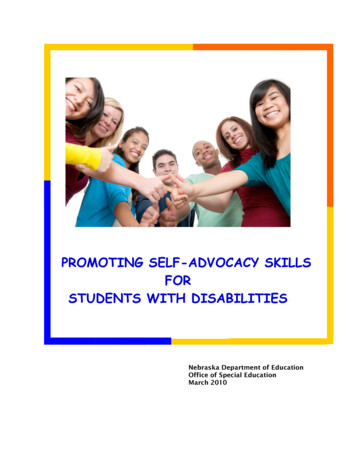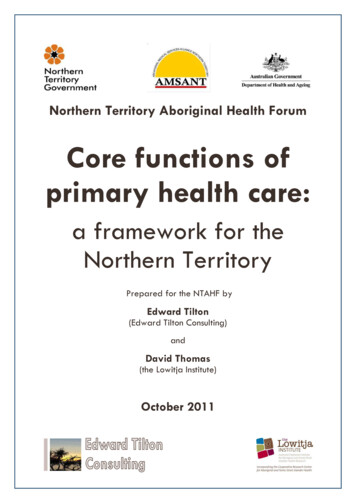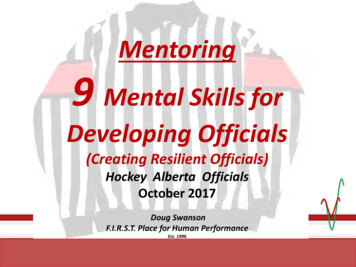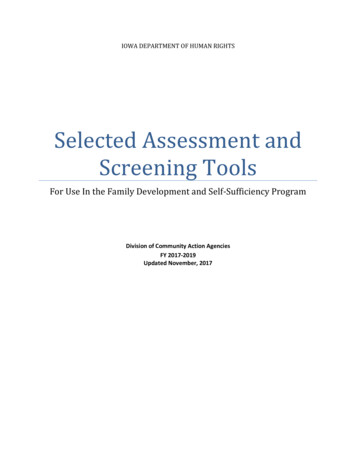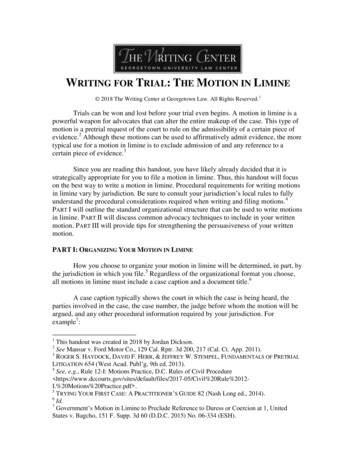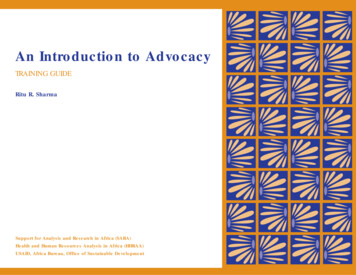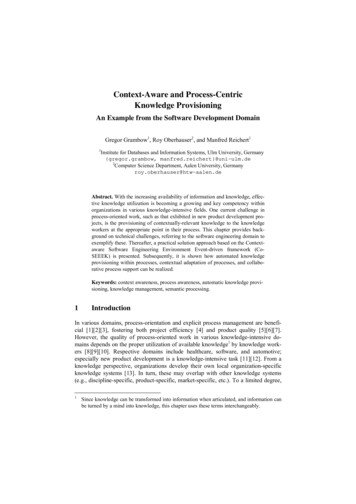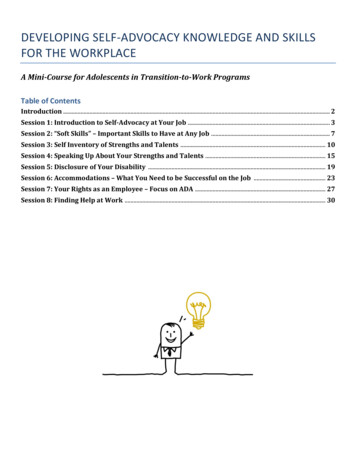
Transcription
DEVELOPING SELF-ADVOCACY KNOWLEDGE AND SKILLSFOR THE WORKPLACEA Mini-Course for Adolescents in Transition-to-Work ProgramsTable of ContentsIntroduction . 2Session 1: Introduction to Self-Advocacy at Your Job . 3Session 2: “Soft Skills” – Important Skills to Have at Any Job . 7Session 3: Self Inventory of Strengths and Talents . 10Session 4: Speaking Up About Your Strengths and Talents . 15Session 5: Disclosure of Your Disability . 19Session 6: Accommodations – What You Need to be Successful on the Job . 23Session 7: Your Rights as an Employee – Focus on ADA . 27Session 8: Finding Help at Work . 30
IntroductionThis curriculum is offered as a framework for guiding students in their development of self-advocacy knowledgeand skills. Its content is divided into eight major sessions: Session 1: Self-Advocacy at Your Job; Session 2: Soft Skills– Important Skills to Have at Any Job; Session 3: Self Inventory of Strengths and Talents; Session 4: Speaking UpAbout Your Strengths and Talents; Session 5: Disclosure of Your Disability; Session 6: Accommodations – What YouNeed to be Successful on the Job; Session 7: Your Rights as an Employee – Focus on ADA; and Session 8: Finding Helpat Work. Each session includes both academic instruction and related activities, with an emphasis on skills practice.The sessions are designed to be one hour in length, with the assumption that a session is only a portion ofstudents’ instructional day. The sessions follow a deliberate sequence, but most can be taught as standalone units.The organization of the individual sessions was planned with an at-a-glance structure and considerable flexibilityfor instructors. The intent was to be respectful of instructors’ time and their knowledge of their students’ abilitiesand level of familiarity regarding self-advocacy in the workplace.At the end of each session, both students and instructors are asked to complete brief evaluations for each session.As this is the initial version of the curriculum, the information collected will be particularly valuable in informingrevisions for a final product.2
Session 1: Introduction to Self-Advocacy at Your JobLearning Objectives Define self-advocacy Describe the key components of self-advocacy Identify critical communication skillsKey Terms and Concepts Advocate Self-advocacy Needs versus wants Negotiate/negotiating Rights ResponsibilitiesInformation to Convey This is the start of a series on self-advocacy. We will cover lots of information in our sessions that will helpyou speak up for yourself at your job—and in other parts of your life. Self-advocacy is speaking up for yourself. There are several steps to successfully advocating for yourself Knowing what you need Asking for what you need Negotiating (working with others to reach an agreement that will meet your needs) Knowing your rights and responsibilities Using resources available to you We will be learning about each of these steps in the days ahead. Good communication skills are essential for successfully advocating for yourself Respectful Appropriate words, tone, body language Clear (specific) Careful listening Asking questions (when you don’t understand or when you need more information)Materials Envelopes containing communication scenarios. Small sheets of paper listing an emotion.3
Session 1: Introduction to Self-Advocacy at Your JobActivity Examples Discussion [What’s been your experience?] - Ask participants if they have been in situations where theyneeded to speak up: What were the circumstances? What did they do? What happened? How did they feel?If they could do it over again, would they change what they did? What did they learn? Participants role play [Different people/different ways to communicate] – Instructors prepare envelopescontaining various scenarios. Participants break into small groups or pairs (or some participants can bechosen). Participants select an envelope, review the scenario, and determine who will be in the role playand what they will say. Possible scenarios include: The boss comes in to talk with you at work. How would you greet him or her? Your boyfriend/girlfriend work at the same store as you. How would you say hi to him/her at work? The phone rings at work. What would you say to answer it? You see your boss at the mall. How would you greet him or her? You see your friends at the mall. How would you greet them? Discuss with the full group when finished. (Adapted from Skills to Pay the Bills) Instructor role play [Speaking respectfully and making your request clear] - 1) Instructor role plays thecontrast of speaking respectfully to a boss or supervisor and speaking inappropriately. Ask participants tocomment. 2) Likewise, role play the contrast of requests that are unclear/vague and requests that areclear/specific (e.g., “It’s not good here. You have to fix it.” vs. “It’s very noisy in the building and it makes ithard for me to do my work. What can you do to make it easier to hear?”). Ask participants to comment. Quick game and discussion [Sending a message without words] - On separate small sheets of paper, writedown an emotion or attitude (e.g., angry, bored, that’s stupid, upset, confident, understanding, etc.). Ask forvolunteers to pick one of the sheets—without showing it to others—and ONLY use body language (nospeaking!) to demonstrate what’s written. Explain that they can use facial expressions, body positions, andmovements to express themselves. Ask the other participants to guess what messages the actors aresending. When finished, discuss with the group the effect body language has when talking to people, especially at ajob.4
Session 1: Introduction to Self-Advocacy at Your JobSummary Briefly recap the content covered Ask participants to complete the evaluation form (Allow time in session) If time permits, ask participants to share comments—based on their evaluation comments or otherthoughts Inform participants of the upcoming topic (Important Skills to Have at Any Job)Resources www.selfadvocacyonline.org Includes short videos of self-advocates and general information about self-advocacy, in easy tounderstand terms. The site is sponsored by the Research and Training Center for Community Living at theUniversity of Minnesota. cate This is the site of the National Collaborative on Workforce and Disability—for Youth (NCWD), whichcontains broad array of information regarding preparing youth for transition to adulthood. This link is forone of NCWD’s information sheets, Youth in Action! Becoming a Stronger Self-Advocate.5
6
Session 2: “Soft Skills” - Important Skills to Have at Any JobReview Briefly summarize key points from the previous session (Self Advocacy at Your Job) Address questions and comments, as time permitsLearning Objectives Define and identify “soft skills” Recognize the relationships between soft skills, getting a job, being successful at work, and keeping a jobKey Terms and Concepts “Soft skills” Communication Enthusiasm and attitude Teamwork Networking Problem solving and critical thinking ProfessionalismInformation to Convey “Soft skills refer to the traits, work habits, and attitudes that all workers across all occupations must haveto obtain, maintain, and progress in employment.” (from Skills to Pay the Bills, Office of DisabilityEmployment Policy) Soft skills are important for any job and are the skills most often desired by employers. You should emphasize these skills and qualities in job interviews and job applications. Here are some general categories of soft skills: Soft skill: Communication – Someone with this skill communicates well to others and listens or receivesinformation from others well. We need to think of communication in the broadest terms: spoken, andunspoken (body language) ways, as well as written/visual forms. All of the other soft skills depend onhaving good communication skills. Soft skills: Enthusiasm & Attitude – Someone with these qualities is upbeat and eager to work; showsinterest in their work and gets the job done; is willing to listen, learn, and try new things; and looks forways to help others. Soft skill: Teamwork – Someone with this skill cooperates with others, works together with others onassignments and projects, contributes ideas to the group and respects differences in opinions. Soft skill: Networking – Someone with this skill makes connections with other people to helphimself/herself find jobs and build his/her career; talks with friends, family members, and other peopleabout his/her goals and interests. Soft skills: Problem solving & Critical thinking – Someone with these skills can identify problems andthink of possible ways to solve the problems. Soft skill: Professionalism – Someone with this quality demonstrates the other five soft skills combinedtogether, is honest, gets along with others, is flexible and adapts to changes, manages time well, workshard and does their best because they know it’s the right thing to do. [Information adapted from Skills to Pay the Bills]7
Session 2: “Soft Skills” - Important Skills to Have at Any JobMaterials Internet access Projector and screenActivity Examples Discussion [What do the soft skills look like?]- Instructor asks participants to give examples of varioussoft skills at the workplace and why they would be important at a job. Video viewing [Soft skills depicted] – tskills/ The Skills to Pay the Bills Curriculum includes video examples of soft skills. Best video clips to view:Soft Skill #2: Enthusiasm & Attitude; Soft Skill #4: Networking; and Soft Skill #6: Professionalism.Discussion should follow after each clip. (The clips are very brief. It may be helpful for participants toview a clip twice.)Summary Briefly recap the content covered. Relate back to overarching theme of self advocacy. Ask participants to complete the evaluation form. (Allow time in session.) If time permits, ask participants to share comments—based on their evaluation comments or otherthoughts Inform participants of the upcoming topic (Self Inventory of Skills & Talents)Resources https://www.dol.gov/odep/topics/youth/softskills/ The Skills to Pay the Bills: Mastering Soft Skills for Workplace Success Curriculum, which was developedby the Office of Disability Employment Policy of the U.S. Department of Labor, is found at this site. Thefull curriculum can be downloaded. Links for video examples of the soft skills and various relatedresources are included.8
9
Session 3: Self Inventory of Strengths and TalentsReview Briefly summarize key points from the previous session (Important Skills to Have at Any Job) Address questions and comments, as time permitsLearning Objectives Identify personal strengths and talents Define hard skills and contrast these with soft skills Recognize the hard skills required for specific jobs Identify soft skills and hard skills related to personal career interestsKey Terms and Concepts Strengths Talents Hard skills Soft skills Job-specific Formal education On-the-job training Realistic self-assessmentInformation to Convey Hard skills are job-specific skills, knowledge, and abilities. They are usually acquired through formaleducation programs and training, including training, on-line courses, certificate programs, as well as onthe-job training. Examples of hard skills include writing, math skills, computer programming, medical skills, automotiveskills, construction, mechanical skills, etc. Hard skills are usually listed in job announcements or job descriptions. To get and keep a job you need a combination of hard and soft skills. It is essential to recognize how your personal strengths and talents relate to your career. It is important to be realistic about your career. Your strengths and talents and training may not be sufficient for what you see as your ideal job. If you can’t qualify for your ideal job, you may be qualified for other work related to your ideal job—what you CAN do. (For example, you can have a strong interest in TV and may want to be a TV reporter,but you do not have the all the education and skills needed for that job. You can still work in a relatedjob at the television station, maybe as a clerk or setting up the equipment, etc.)10
Session 3: Self Inventory of Strengths and TalentsMaterials List of soft and hard skills Easel paper (or individual sheets of tablet paper for participants) Self-inventory (strengths, talents, previous work experience, job interests)Activity Examples Group activity -Soft skills v. hard skills [Sorting it out] – Instructor posts two sheets of easel paper, onelabeled “soft” and one labeled “hard.” Instructor reads the numbered list of skills provided. Participantscan call out whether the skill is soft or hard. Instructor asks participants to explain their answers andthen writes the skill on the appropriate sheet. Variation: Participants make two columns (Soft – Hard)on a sheet of paper. As the instructor reads the skills, participants list the number (e.g., #4 Willingnessto learn new things) in one of the columns. Participants compare lists when finished. Self-reflection* - Participants complete a Personal Inventory, including information about theirstrengths, talents, previous work experience, and job interests. Note: * This activity is essential for upcoming sessions and should be a priority for the session.Summary Briefly recap the content covered. Relate back to overarching theme of self advocacy Ask participants to complete the evaluation form (Allow time in session) If time permits, ask participants to share comments—based on their evaluation comments or otherthoughts Inform participants of the upcoming topic (Speaking Up about Yourself) IMPORTANT: Ask participants to bring their personal inventories to the next sessionResources Blogs “Soft versus hard skills” is a common topic on business and training program blogs. A quick search ofthe Internet yields numerous sites. http://www.careeronestop.org/Toolkit/toolkit.aspx Comprehensive source for information on career exploration, training, and jobs. Includes informationon writing resumes, designing a skills profile, etc. Notable section allows users to enter current or pastjobs to find possible career matches. Site is sponsored by the U.S. Department of Labor.11
ACTIVITY: SORTING HARD SKILLS AND SOFT .19.20.21.22.23.24.25.CooperationSpelling and grammarMechanical skillsTeam skillsHonestyReading and comprehensionUse of case registersHigh school diplomaManufacturing skills trainingCommunication skills with fellow workers, supervisors, and customersMathCourtesyMotivation to do a good jobAdaptabilityDriver’s licenseStaying with a task until it’s finishedUse of technology toolsNeat personal appearanceWillingness to listenCarpentryProblem solving skillsCommon senseFirst aid courseBeing on timeWork experience12
SELF INVENTORY WORKSHEETNAMEMY STRENGTHS (Consider your soft skills.)MY TALENTS (Consider your hard skills.)MY WORK EXPERIENCEMY JOB INTERESTS13
14
Session 4: Speaking Up About Your Strengths and TalentsReview Briefly summarize key points from the previous session (Personal Inventory of Strengths and Talents Address questions and comments, as time permitsLearning Objectives Articulating strengths and talents Giving and receiving feedbackKey Terms and Concepts Preparation Self-inventory Job description Rehearsing Feedback Constructive criticismInformation to Convey For interviews, appointments to talk with an employer, or other important meetings, it is always best toprepare ahead of time. Your personal inventory contains valuable information for an employer, but this is not a document thatyou give to an employer or read to an employer. A Self Inventory is a way for you to think about your strengths, talents, and interests and to collect yourthoughts. You need to use that information to develop a summary. You need to pick out the most important qualities and skills to share with an employer. Usually,individuals who are applying for a job or who want to change jobs within their current worksite look atthe job description for that position and emphasize the qualities and skills that match the particularposition. Practicing what you want an employer to know about you—strengths, talents, previous work experience,interests—will help you feel more comfortable and less nervous when you do talk with an employer. Be sure to keep in mind all the things your teachers have said to you about speaking, like having goodposture, making eye contact, organizing your thoughts before speaking, etc. It is helpful to practice with people you trust and to get their feedback. Often the feedback gives you cluesas to how you can improve what you’re saying. When you give feedback to others, it should always be respectful and constructive.15
Session 4: Speaking Up About Your Strengths and TalentsMaterials Paper for participants to develop summaries based on the Self Inventory Feedback Sheet (eachparticipant will need multiple copies to rate peers)Activity Examples Summarizing strengths and talents, etc. – Participants use the Personal Inventory they completed in thepast session to write a summary. Instructor reminds participants that they have to prioritize the mostimportant information. Practice – Each participant will present his or her personal summary and receive feedback commentsfrom the other participants. Based on the time available and the individuals in the class, the instructorcan decide whether participants present to the full group or whether they practice in small groups. Aftereach presentation, the remaining participants will share feedback with the presenter. (Participants canuse a worksheet to record their feedback/comments before sharing with the group.)Summary Briefly recap the content covered. Relate back to overarching theme of self advocacy Ask participants to complete the evaluation form (Allow time in session) If time permits, ask participants to share comments—based on their evaluation comments or otherthoughts Inform participants of the upcoming topic (Disclosure)Resources http://www.wikihow.com/Be-a-Good-Speaker Briefly explains 13 general steps for good speaking. Includes cartoon-like illustrations.16
FEEDBACK SHEETName of speakerCONSIDER THESE:Circle the words below that describe the speaker’spresentation.VoiceSpeaking pacetoo loudhard to heargoodtoo fasttoo slowgoodPostureneeds improvementgoodEye contactneeds improvementgoodMessage/ideasunorganizedTimingtoo enthusiasticWhat did the speaker do well?How can the speaker improve?17
18
Session 5: Disclosure of Your DisabilityReview Briefly summarize key points from the previous session (Speaking Up about Your Strengths and Talents) Address questions and comments, as time permitsLearning Objectives Define disclosure Identify advantages to disclosure Identify disadvantages to disclosure Consider your personal view of disclosing a disabilityKey Terms and Concepts Disclosure Intentional Personal decision Advantages and disadvantages Confidential Accommodations (to be covered in detail in the next session) Exclusion Self-imageInformation to Convey In general, “disclose” means to tell something or reveal something. When we disclose, we areintentionally providing personal information about ourselves. For this session, when we talk about “disclosure,” we specifically mean telling or revealing informationabout our health or disability. Disclosing information about a disability is a personal decision—about what and to whom you want togive the information. There are advantages and disadvantages to disclosing information about your disability. (Handoutincluded)19
Session 5: Disclosure of Your DisabilityMaterials Link to Difficulties of Disabilities Disclosure: fdisability-disclosure/ Handout of disclosure advantages and disadvantages. Reference 8-5 & 8-6 of The 411on Disability Disclosure for discussion ideas.Activity Examples Read Aloud - Read Emily Ladau's blog outloud on the "Difficulties of Disability Disclosure" Discussion – After reviewing the handout listing advantages and disadvantages of disclosure, instructorasks participants about their views (positive or negative) in general. Instructor provides examples of situations when participants might choose to disclosure. Participantsoffer pros and cons of disclosing in each situation. Third-party phone call or reference In a letter of application or resume In a cover letter Pre-interview On the employment application At the interview After he or she has been offered a job During the course of employment NeverSummary Briefly recap the content covered. Relate back to overarching theme of self advocacy Ask participants to complete the evaluation form (Allow time in session) If time permits, ask participants to share comments—based on their evaluation comments or otherthoughts Inform participants of the upcoming topic (Job Accommodations)Resources osure This is the Job Accommodations Network, sponsored by the Office of Disability Employment Policy(ODEP) of the U.S. Department of Labor. It is the premier “Go To” site for information aboutaccommodations.20
DISCLOSURE OF YOUR DISABILITY*Adapted from 411 Disability DisclosureAdvantages It allows you to receive reasonable accommodations so that you can work more effectively.It provides legal protection against discrimination (as specified in the Americans with DisabilitiesAct).It reduces stress, since protecting a “secret” can take a lot of energy.It ensures that you are getting what you need in order to be successful (for example, through anaccommodation).It can improve your self-image through self- advocacy.It increases your comfort level.Disadvantages It could lead to the experience of being excluded.It could lead to your being treated differently than others.It could bring up conflicting or negative feelings about your self-image.It could cause other people to view you as needy, not self-sufficient, or unable to perform as wellas your peers.It could cause you to be overlooked for a job, team, group, or organization.Disclosing personal and sensitive information could be extremely difficult and/or embarrassing.21
22
Session 6: Accommodations - What You Need to beSuccessful on the JobReview Briefly summarize key points from the previous session (Disclosure of Your Disability) Address questions and comments, as time permitsLearning Objectives Define accommodations Identify accommodations needed for specific jobs Communicate with an employer regarding personal accommodations neededKey Terms and Concepts Accommodations Environment Equal accessInformation to Convey Previous discussions/sessions focused on how both soft skills and hard skills are needed to be successfulon the job. These are important “ingredients” that you are responsible to bring to your job. Sometimes a person may have good soft skills and hard skills, but still need some supports to be able todo a job or to do a job well. These supports are called accommodations. Job accommodations are adjustments made to the environment, the workspace, the building, or the worktask. A job accommodation allows an individual with a disability to apply for a job, do the job, or enjoy equalaccess to benefits available to other individuals in the workplace. Accommodations are based on an individual’s needs to be able to do their job. Some accommodations may be simple (e.g., more time to do a task, a picture sequence for the steps of atask) and some may be more complicated and more expensive (e.g., a table with height adjustments for awheelchair, special computer software). There is a special website that can help you identify accommodations that you might need: JobAccommodation Network. The web address is www.askjan.org.Materials Accommodations Worksheet Internet access Projector and screen23
Session 6: Accommodations - What You Need to beSuccessful on the JobActivity Examples Discussion – Instructor asks participants about accommodations they may be using currently:How do they help? Are there other supports that they would like to have—and why? Information research – Instructor explores the Job Accommodation Network (JAN) website,www.askjan.org with participants. Be sure to examine the section titled A to Z of Disabilities andAccommodations. It offers information on accommodations and can be searched by three majorcategories: disability, related topics, and specific limitations. Identifying specific needs – Instructor directs participants to complete the brief AccommodationsWorksheet. Participants can refer to the Ask JAN website for relevant information. Role play [Talking with an employer about accommodations]– Instructor pairs up participants torole play talking to an employer about accommodations they may need. Each participant shouldtake a turn to practice. Participants can use the bulleted list at the end of the AccommodationsWorksheet as a guide for their statements to their employer.Summary Briefly recap the content covered. Relate back to overarching theme of self advocacy Ask participants to complete the evaluation form (Allow time in session) If time permits, ask participants to share comments—based on their evaluation comments orother thoughts Inform participants of the upcoming topic (Rights at Work)Resources www.askjan.org This is the Job Accommodations Network, sponsored by the Office of Disability EmploymentPolicy (ODEP) of the U.S. Department of Labor. It is the premier “Go To” site for informationabout accommodations. http://www.ncwd-youth.info/assets/guides/411/411 Disability Disclosure complete.pdf Unit 5 of this 411 Disability Disclosure manual by the National Collaborative on Workforce andDisability for Youth (NCWD) focuses on accommodations.24
ACCOMODATIONS WORKSHEETNameHow does my disability show itself? What does it look like?What job am I working at or interested in?What accommodations/help do I need in this job?***************************ASKING FOR ACCOMMODATIONSWhen you talk with your employer to ask for accommodations, you should Introduce yourselfShare some of your strengths and job-related talentsState your disability and difficulties you are having with your jobExplain what you do to accommodate your disabilityAsk for specific accommodationsThank your employer for talking with you(Adapted from Stepping Forward – Connecticut Parent Advocacy Center)25
26
Session 7: Your Rights as an Employee – Focus on the ADAReview Briefly summarize key points from the previous session (What You Need to Be Successful on the Job) Address questions and comments, as time permitsLearning Objectives Define discrimination Describe the employment rights under the Americans with Disabilities Act for an individual with a disability Recognize the responsibilities of an individual with a disability according to ADA Recognize situations in which the rights of an individual with a disability are being denied or negatively affectedin the workplaceKey Terms and Concepts Discrimination Americans with Disabilities Act (ADA) Federal law Equal opportunity Access Rights and responsibilities Reasonable accommodations Undue burden/Undue hardship Violate/violationInformation to Convey We know that it is wrong to discriminate against people because of their race, color, religion, sex, age, disability, orwhere they were born. In the United States there are laws against discrimination. The Americans with Disabilities Act (ADA) is perhaps the most important federal law regarding the rights ofindividuals with disabilities. The ADA is considered an “equal opportunity” law for people with disabilities and prohibits discrimination in manyaspects of daily life, for example as in access to public facilities and transportation. Regarding employment and the workplace, the ADA makes it unlawful to discriminate against individuals in keypractices: recruitment, hiring/firing, training, assignments, pay, benefits, leave, etc. Under the ADA, individuals with disabilities who are attempting to get a job or who are employees already also havecertain responsibilities: a) They must be qualified to do the job; b) They must disclose their disability (self identify) tothe employer if they intend to request accommodations; c) They must ask an employer to provide the neededaccommodations that are not currently available to them. Under the ADA, an employer has to provide accommodations that are considered “reasonable” and do not cause“undue burden” for the employer. A “reasonable accommodation” may be any change or adjustment to a job, the work environment, or the way work isdone that allows a qualified person with a disability to perform the essential functions of a job or to receive thebenefits and privileges of employment, which are av
Session 2: “Soft Skills” - Important Skills to Have at Any Job Materials Internet access Projector and screen Activity Examples Discussion [What do the soft skills look like?]- Instructor asks participants to give examples of various soft skills a
